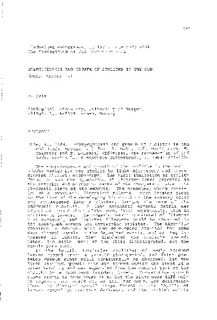| dc.description.abstract | The embryogenesis and growth of the otoliths in the cod
(Gadus morhua L.) was studied by light microscopy and transmission
electron microscopy. The first indication of otolith
formation was the appearance of electron-dense granules in
the anterior and posterior parts of the otocysts at about the
30-somite stage of the embryos. The granules, which consisted
of a condensed, flocculent material, were located close
to the tips of the developlng kinocilia on the sensory cells
and accumulated into a cluster, forming the core of the
embryonic otoliths. A less condensed organic matrix was
deposited around the otolith core, first segmentally, then in
continuous layers. The organic matrix consisted of filamentous
material, and isolated filaments could be observed in
the endolymph around the developlng otoliths. The kinocilia
remained in contact with the developlng otoliths for some
days through canals in the deposited matrix, and as they increased
in lenqth, they displaced the otoliths upward.
Later, the distal part of the cilla disintegrated, but the
canals persisted.
In the lapilli (utricular otoliths) of newly hatched
larvae reared under a 12L-12D photoperiod, 1-2 faint prehatch
growth rings could occasionally be observed, but the
first distinct growth ring was formed during the first 24 h
after hatchlng and was separated from the central part of the
otolith by a prominent boundary layer. Consecutive growth
rings seemed to form every 24 h , but the rings were difficult
to separate and could not be used for exact age determination.
No distinct growth rings formed in the lapilli of
larvae reared in constant darkness, and the otolith matrix
little condensed, making these otoliths somewhat bigger
and rounder than "normal" otoliths of he same age. No
regular zone formation occurred in the lapilli of larvae
reared in constant light. The distribution of precipitated
calcium pyroantimonate in the otoliths suggested that the
calcification of the otoliths started at hatching.
Light microscopy of transverse sections through the
otocysts of larvae showed that the lapillus was located over
a horizontal sensory epithelium, whereas the posterior
saccular otolith, the sagitta, was located near the medial
wall of the otocyst, beside a vertical sensory epithelium.
The lapillus was somewhat bigger than the sagitta at the
early larval stage. Occasionally, a third body, which
probably represented the developing third otolith, the
asteriscus, could be observed in the dorsal part of the
otocyst at the late embryonic stage. | en |
